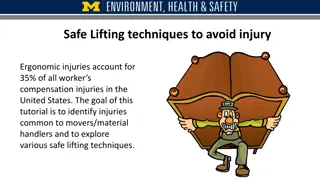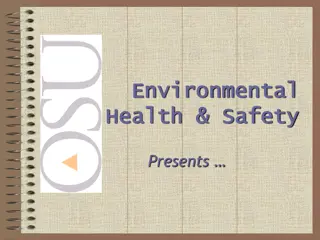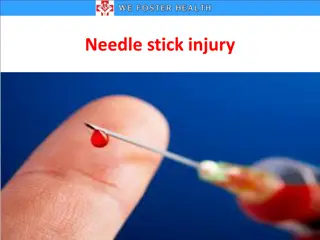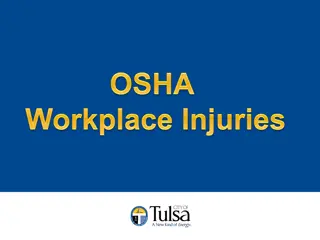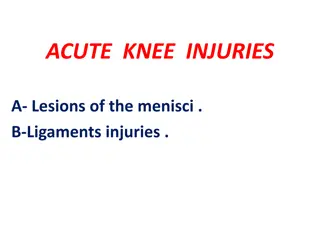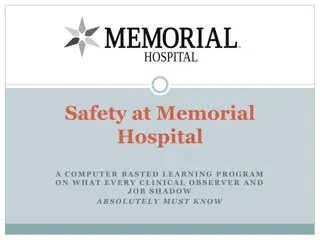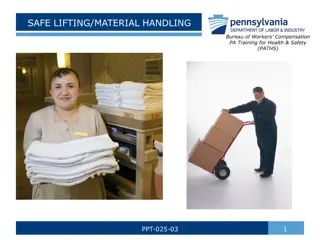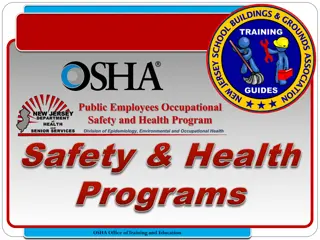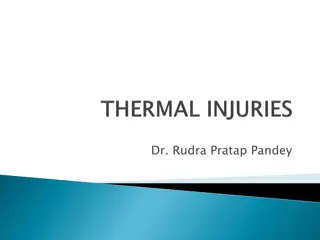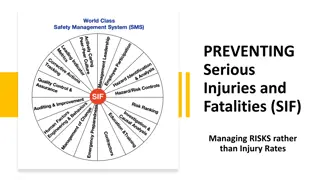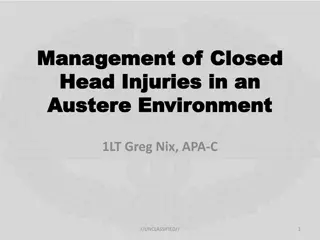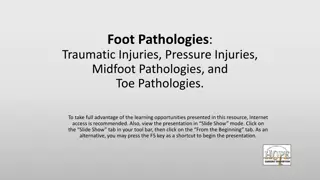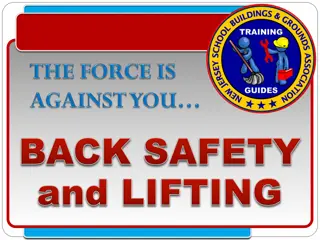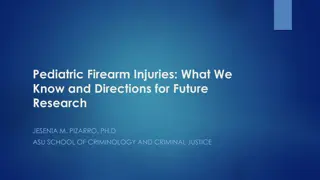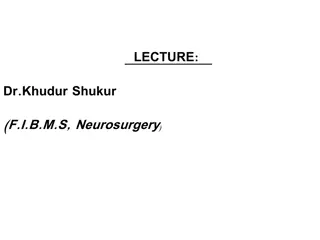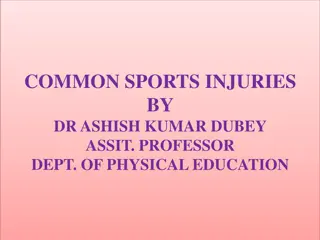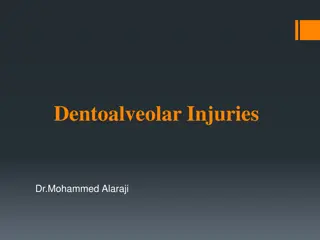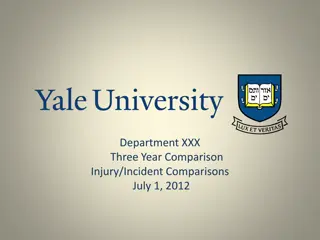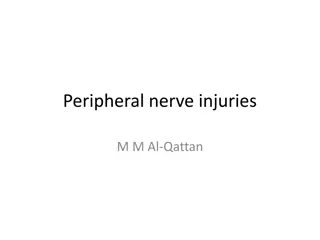Comprehensive Guide on Injury, Poisoning, and External Causes
This detailed guide covers various aspects of injuries, poisonings, and other consequences from external causes. It includes information on ICD10 and ICD9 coding, recording and treatment details, vocabulary related to different types of injuries, body parts classification, and code structures for di
2 views • 39 slides
Safe Lifting Techniques to Avoid Ergonomic Injuries: A Comprehensive Guide
Ergonomic injuries are a significant concern in the workplace, with musculoskeletal disorders being a common result. This tutorial explores the risks faced by movers/material handlers and provides insights into safe lifting techniques to prevent injuries. Understanding the importance of ergonomics i
6 views • 21 slides
Switch On for Safety: Return to Workplace Mindset
Returning to the workplace after a holiday calls for a conscious switch to a safe mindset, reducing susceptibility to injury. Taking responsibility for Health & Safety by speaking up, ensuring safe practices, and recognizing positive behaviors can shape a safer tomorrow. Awareness of common workplac
4 views • 5 slides
Needlestick Injuries Prevention and Safety
Prevent needlestick injuries by avoiding unnecessary needle use, using devices with safety features, and implementing safe work practices. Healthcare professionals should report injuries promptly, participate in training, and get vaccinated. Be cautious when handling surgical sharps to prevent injur
5 views • 10 slides
Workplace Hazards and Safety Measures Awareness
Learn about common workplace hazards such as falls, chemical exposure, fire, electrical hazards, and repetitive motion injuries. Understand the risks associated with these hazards and the importance of prioritizing safety in the workplace to prevent accidents and injuries. Stay informed and take pro
1 views • 33 slides
Workplace Adjustments and Employee Lifecycle Overview
This content discusses the key stages in the employee lifecycle where workplace adjustments may be necessary to support employees effectively. It emphasizes the importance of providing reasonable adjustments as required under the Equality Act 2010, especially during recruitment, induction, performan
3 views • 4 slides
Workplace Safety: Preventing Back Injuries for a Healthier Future
Understanding the importance of back safety in the workplace to prevent debilitating injuries and costly consequences. Learn proper lifting techniques and back care basics to safeguard against back problems. Discover why back injuries occur and how to protect your spine for long-term well-being.
1 views • 48 slides
Understanding Needle Stick Injuries and Prevention
Needle stick injuries are percutaneous piercing wounds caused by needles or other sharp instruments. They pose significant risks, including exposure to blood-borne diseases. Health-care workers are particularly vulnerable, with millions experiencing such injuries annually. Proper training, safe prac
0 views • 35 slides
Understanding OSHA Workplace Injuries Data Analysis
Analyze OSHA workplace injuries data from 2015 to 2017, including total recordable incident rates, number of injuries, total hours worked, city injury rates, and top locations with high injury rates. Explore the importance of using incident rates over total injury numbers and how departments benefit
0 views • 15 slides
Understanding Acute Knee Injuries: Meniscal Tears and Ligament Injuries
Acute knee injuries, such as meniscal tears and ligament injuries, are commonly caused by trauma or twisting motions. Meniscal tears can lead to pain, swelling, and locking of the knee joint, especially in young active individuals. Understanding the anatomy of the knee joint and meniscus, along with
1 views • 56 slides
Ensuring Patient Safety and Preventing Workplace Injuries at Memorial Hospital
Patient safety is emphasized for all staff at Memorial Hospital, including non-clinical personnel. Everyone plays a role in maintaining a safe environment. The article highlights important practices like reporting hazards, ensuring confidentiality, and improving processes. It also addresses preventi
0 views • 16 slides
Workplace Safety and OSHA Regulations for Phlebotomists
Learn about the importance of workplace safety and OSHA regulations for phlebotomists, including tips on cleanliness, following guidelines, and penalties for violations. It covers the critical need to prevent injuries and exposure to bloodborne illnesses in the workplace through proper practices and
0 views • 29 slides
Importance of Job Hazard Analysis (JHA) in Workplace Safety
Job Hazard Analysis (JHA) is a crucial technique that focuses on identifying and mitigating hazards in work environments to prevent injuries, illnesses, and property damage. This analysis involves breaking down job tasks, identifying potential hazards, implementing controls, and providing necessary
0 views • 13 slides
Understanding Vehicle Collisions: Causes, Types, and Injuries
Vehicle collisions involve various types such as front impacts, side impacts, and rear-end collisions, resulting in different injuries like back and head injuries, neck injuries, soft tissue damage, broken bones, and internal injuries. Understanding the causes and effects of collisions can help prev
0 views • 14 slides
Safe Lifting and Material Handling Tips for Workplace Safety
This informative content provides essential tips and considerations for safe lifting and material handling in the workplace. It covers topics such as checking objects before lifting, testing loads, proper lifting techniques, and planning ahead to prevent injuries. By following these guidelines, empl
0 views • 37 slides
Comprehensive Workplace Safety and Health Program Overview
Explore the key elements of a robust workplace safety and health program, including benefits, major elements, management commitment, policy and goals, and employee involvement. Learn how such programs can reduce work-related injuries, enhance productivity, and foster a culture of safety in the workp
1 views • 21 slides
Overview of Burn and Scald Injuries and Classification
Burn injuries from dry heat and scald injuries from hot liquids or steam are common forms of thermal injuries. Other etiological classifications include exposure to chemicals, electrical energy, and radiation. The extent of tissue damage is directly related to temperature and duration. Classificatio
1 views • 31 slides
First Aid Tips for Common Trauma Injuries
Learn how to manage various trauma injuries such as skull fractures, eye injuries, blowout fractures, epistaxis, mouth injuries, soft tissue injuries, open injuries, and penetrating wounds with practical first aid techniques. From treating bleeding and impaled objects to saving dislodged teeth and c
0 views • 16 slides
Preventing Road Traffic Injuries: A Global Perspective
Road traffic injuries are a significant global issue, causing millions of deaths and injuries annually. This report highlights the complexity and dangers of road traffic systems, emphasizing the need for increased awareness and preventive measures at governmental, industrial, and individual levels.
1 views • 27 slides
Complications of Fractures: Types and Risks
Complications of fractures can be classified as general, local early, and late complications. General complications include shock, embolisms, and fever while local complications involve injuries to nearby tissues and infections. Early local complications can lead to visceral, vascular, nerve injurie
0 views • 29 slides
Preventing Serious Injuries and Fatalities (SIF): A Paradigm Shift in Workplace Safety
The SIF approach emphasizes managing risks over injury rates to prevent serious workplace incidents. Traditional safety metrics focusing on minor injuries may not effectively prevent SIF events. Special attention and a new safety paradigm are needed to address high-risk workplaces and protect worker
0 views • 16 slides
Importance of Personal Protective Equipment in Workplace Safety
Personal Protective Equipment (PPE) plays a crucial role in safeguarding workers from workplace hazards like physical, electrical, mechanical, and chemical risks. PPE includes safety shoes, helmets, goggles, masks, overalls, harnesses, gloves, earplugs, vests, ear muffs, and face shields. Employers
0 views • 6 slides
Importance of Health and Safety in the Workplace
Health and safety are crucial for all employees, as outlined in the Ontario Health and Safety Act. Employers and employees share the responsibility of creating a safe work environment through enforcement, compliance, and partnership. Understanding hazards, both safety and health-related, is key in p
0 views • 24 slides
Understanding Mechanical Injuries: Types, Classification, and General Principles
Mechanical injuries encompass a variety of harms caused to the body, mind, reputation, or property. These injuries can be classified into medical, legal, and medico-legal categories based on factors like intentionality. The types of mechanical injuries range from blunt force trauma to thermal, chemi
0 views • 79 slides
Management of Closed Head Injuries in an Austere Environment Overview
Understanding the pathophysiology of brain injuries, including intracranial pressure changes and specific injuries such as traumatic brain injury (TBI), skull fractures, brain bleeds, and diffuse axonal injuries. It covers classifications, diagnosis, and treatment approaches for mild/concussion, mod
0 views • 27 slides
Understanding Foot Pathologies: Traumatic Injuries and Pressure Injuries
Explore common foot pathologies including traumatic injuries like plantar fasciitis, turf toe, and sprains, as well as pressure injuries such as plantar ulcers and heel spurs. Learn about the causes, symptoms, and treatment options for these conditions.
0 views • 33 slides
Understanding Back Injuries and Prevention Methods
More than 1 million workers suffer from back injuries each year, accounting for a significant portion of workplace injuries. These injuries are not only painful but can also have long-term effects. It is crucial to learn how to avoid injuring or re-injuring your back to prevent pain and avoid potent
1 views • 32 slides
National Day of Mourning - Honoring Lives Lost in Workplace Tragedies
The National Day of Mourning on April 28th commemorates those who have lost their lives or suffered injuries due to work-related incidents. It serves as a reminder to prioritize workplace safety and prevent further tragedies. Statistics highlight the stark reality of workplace fatalities and injurie
0 views • 8 slides
Understanding Pediatric Firearm Injuries and Future Research Directions
Pediatric firearm injuries are a significant public health concern, with thousands of American children affected annually. Research gaps exist in understanding the causes, consequences, and prevention strategies for pediatric firearm injuries. The lack of surveillance data and research funding hinde
0 views • 16 slides
Understanding Injuries to the Cervical and Thoracolumbar Spine
Cervical spine injuries are common, especially in the 15-30 age group, with motor vehicle accidents, falls, and sports being major causes. Male individuals are more prone to injuries. Neurological deficits are associated with specific types of injuries, necessitating prompt imaging for spinal cord i
0 views • 20 slides
Understanding Pressure Ulcers and Tissue Injuries Progression
Pressure ulcers, also known as pressure injuries, are localized damages to the skin and underlying soft tissue usually over bony prominences. The National Pressure Ulcer Advisory Panel changed the terminology in 2016 to classify all stages as injuries, not just ulcers. Stages range from non-blanchab
0 views • 13 slides
Understanding Birth Injuries in Newborns
Birth injuries in newborns can result from various factors during the birthing process, such as soft tissue injuries and head trauma. Soft tissue injuries like facial abrasions and scleral hemorrhage may occur due to causes like dystocia and forceps delivery. Nursing care involves assessing and reas
0 views • 19 slides
Understanding Upper Extremity Injuries and Shoulder Physiology
Upper extremities are prone to various injuries in sports, including sprains, strains, dislocations, fractures, and repetitive motion injuries like arthritis and tendonitis. The shoulder complex involves bones, muscles, tendons, ligaments, and articulations. Joints like the sternoclavicular, acromio
0 views • 63 slides
Understanding Common Sports Injuries by Dr. Ashish Kumar Dubey
Dr. Ashish Kumar Dubey, Assistant Professor in the Department of Physical Education, categorizes common sports injuries into soft tissue injuries, bone injuries, and joint injuries. Soft tissue injuries include sprains, strains, contusions, abrasions, lacerations, and incisions. Sprains are ligament
0 views • 7 slides
Enhancing Workplace Safety Through CRT Testing Programs
Assure the effectiveness of your workforce by implementing Cost Reduction Technologies (CRT) Isokinetic Testing and Special Statistical Analysis. These programs offer significant benefits such as reduced workplace injuries, minimized downtime, savings on compensation costs, and improved compliance w
0 views • 5 slides
Understanding Dentoalveolar Injuries: Causes and Classification
Dentoalveolar injuries refer to trauma affecting the teeth and their supporting structures. These injuries can range from isolated incidents to significant maxillofacial damage. They are classified into categories based on the affected tissues, including hard dental tissues, pulp, periodontal tissue
1 views • 18 slides
Workplace Violence Prevention Training & Discrimination in the Workplace
Workplace violence prevention training is crucial to ensure safety in the workplace. This training covers the definition of workplace violence, types of violence, actions that must be reported, and worst-case scenarios. It emphasizes avoiding disruptive behaviors like verbal abuse and outlines incid
0 views • 23 slides
Workplace Injury and Workers' Compensation Analysis
Comparison of workers' compensation claims and injury data over a three-year period in Department XXX reveals trends in claim costs, types of injuries, days lost, and activities leading to injuries. The analysis includes a breakdown of costs incurred, costs paid, types of claims, days on modified du
0 views • 14 slides
Overview of Peripheral Nerve Injuries and Brachial Plexus Injuries
Explore different types of peripheral nerve injuries including Erb's palsy, Klumpke palsy, isolated axillary nerve injury, and isolated musculocutaneous nerve injury. Learn about the anatomy, causes, motor and sensory exams, and management of these injuries. Understand the myotomes and dermatomes as
0 views • 19 slides
Understanding Finger Injuries and Proper Assessment Guidelines
Hand injuries, especially finger injuries, are common in emergency departments. Proper diagnosis and management are crucial to prevent long-term complications. This content covers information on tendon anatomy, nerve innervation, and assessment guidelines for finger injuries.
0 views • 67 slides

